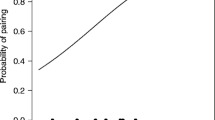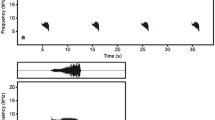Summary
In a Swedish population of the polygynous great reed warbler Acrocephalus arundinaceus, about 40% of the males formed pairs with more than one female. Males sang two completely separated types of song: (1) long song when they tried to attract mates and (2) short shong when they guarded a fertile female. As soon as a male had attracted a female he immediately switched from long to short song and apparently guarded her for at least 3 days. Most males left their female and started singing long several days before her fertile period ended. This behavior probably increased the risk of cuckoldry. By assuming that males of polygynous species maximize their fitness over the whole breeding season (i.e., maximize fitness rate), we predicted longer mate guarding periods when the probability of attracting a second female was low and the risk of cuckoldry was high. These predictions were supported by observations. The probability of attracting a second female decreased during the breeding season and, in accordance, the number of days that males sang long song during the primary female's fertile period was negatively correlated with the time of the season. This trend held also for individual males when comparing mating periods of their primary and secondary female. The increasing rate of male intrusions with season may also have contributed to the increasing mate guarding periods.
Similar content being viewed by others
References
Alatalo RV, Lundberg A (1984) Polyterritorial polygyny in the pied flycatcher Ficedula hypoleuca: evidence for the deception hypothesis. Ann Zool Fenn 21:217–228
Alatalo RV, Carlson A, Lundberg A, Ulfstrand S (1981) The conflict between male polygamy and female monogamy: the case of the pied flycatcher Ficedula hypoleuca. Am Nat 117:738–755
Alatalo RV, Lundberg A, Stählbrandt K (1982) Why do pied flycatcher females mate with already mated males? Anim Behav 30:585–593
Alatalo RV, Gustavsson L, Lundberg A (1984) High frequency of cuckoldry in pied and collard flycatchers. Oikos 42:41–48
Alatalo RV, Gottlander K, Lundberg A (1986) Extra-pair copulations and mate guarding in the polyterritorial pied flycatcher Ficedula hypoleuca. Behaviour 100:139–155
Arak A (1984) Sneaky breeders. In: Barnard CJ (ed) Producers and scroungers. Croom Helm, Beckenham, pp 154–194
Beecher MD, Beecher MI (1979) Sociobiology of bank swallows: reproductive strategy of the male. Science 205:1282–1285
Birkhead TR (1979) Mate guarding in the magpie Pica pica. Anim Behav 26:321–331
Birkhead TR (1982) Timing and duration of mate guarding in magpies Pica pica. Anim Behav 30:277–283
Birkhead TR (1987) Sperm competition in birds. Trends Ecol Evol 2:268–272
Birkhead TR (1988) Behavioural aspects of sperm competition in birds. Adv Study Behav 18:35–72
Birkhead TR, Johnson SD, Nettleship DN (1985) Extra-pair copulations and mate guarding in the common murre Uria aalge. Anim Behav 33:608–619
Birkhead TR, Atkin L, Møller AP (1987) Copulation behaviour of birds. Behaviour 101:101–138
Birkhead TR, Clarkson K, Zann R (1988a) Extra-pair courtship, copulation and mate guarding in wild zebra finches Taeniopygia guttata. Anim Behav 36:1853–1855
Birkhead TR, Pellatt J, Hunter FM (1988b) Extra-pair copulation and sperm competition in the zebra finch. Nature 334:60–62
Birkhead TR, Hunter FH, Pellatt JE (1989) Sperm competition in the zebra finch Taeniopygia guttata. Anim Behav 38:935–950
Björklund M, Westman B (1983) Extra-pair copulation in the pied flycatcher Ficedula hypoleuca: a removal experiment. Behav Ecol Sociobiol 13:271–275
Bray O, Kennedy J, Guarion J (1975) Fertility of eggs produced on territories of vasectomized blackbirds. Wilson Bull 87:187–195
Carlson A, Hillström L, Moreno J (1985) Mate guarding in the wheatear Oenanthe oenanthe. Ornis Scand 16:113–120
Catchpole CK (1983) Variation in the song of the great reed warbler Acrocephalus arundinaceus in relation to mate attraction and territorial defence. Anim Behav 31:1217–1225
Catchpole CK, Leisler B, Winkler H (1985) Polygyny in the great reed warbler Acrocephalus arundinaceus: a possible case of deception. Behav Ecol Sociobiol 16:285–291
Catchpole CK, Leisler B, Dittami J (1986) Sexual differences in the responses of captive great reed warblers Acrocephalus arundinaceus to variation in song structure and repertoire size. Ethology 73:69–77
Charnov EL, Skinner SW (1984) Contemporary approaches to the understanding of parasitoid oviposition decisions. Environ Entomol 14:383–391
Davies NB (1985) Cooperation and conflict among dunnocks, Prunella modularis, in a variable mating system. Anim Behav 33:628–648
Dyrcz A (1986) Factors affecting facultative polygyny and breeding results in the great reed warbler Acrocephalus arundinaceus. J Ornithol 127:447–461
Emlen ST, Oring LW (1977) Ecology, sexual selection, and the evolution of mating systems. Science 197:215–223
Ezaki Y (1987) Male time budgets and recovery of singing rate after pairing in polygamous great reed warblers. Jpn J Ornithol 36:1–11
Fitch MA, Shugart GW (1984) Requirements for a mixed reproductive strategy in avian species. Am Nat 124:116–126
Ford NL (1983) Variation in mate fidelity in monogamous birds. In: Johnston RF (ed) Current ornithology 1. Plenum Press, New York London, pp 329–356
Gladstone DE (1979) Promiscuity in monogamous colonial birds. Am Nat 114:545–557
Gottlander K (1987) Variation in the song rate of the male pied flycatcher Ficedula hypoleuca: causes and consequences. Anim Behav 35:1037–1043
Grafen A (1980) Opportunity cost, benefit and degree of relatedness. Anim Behav 28:967–968
McKinney F, Cheng KM, Bruggers DJ (1984) Sperm competition in apparently monogamous birds. In: Smith RL (ed) Sperm competition and the evolution of animal mating system. Academic Press, New York, pp 523–545
Monnett C, Rotterman L, Worlein C, Halupka K (1984) Copulation patterns of red-winged blackbirds Agelaius phoeniceus. Am Nat 124:757–764
Moore MC (1984) Changes in territorial defense produced by changes in circulating levels of testosterone: a possible hormonal basis for mate-guarding behaviour in white-crowned sparrows. Behaviour 88:215–226
Møller AP (1985) Mixed reproductive strategy and mate guarding in a semi-colonial passerine, the swallow Hirundo rustica. Behav Ecol Sociobiol 17:401–408
Møller AP (1987a) Mate guarding in the swallow Hirundo rustica: an experimental study. Behav Ecol Sociobiol 21:119–123
Møller AP (1987b) Extent and duration of mate guarding in swallows. Ornis Scand 18:95–100
Møller AP (1987c) Behavioural aspects of sperm competition in swallows Hirundo rustica. Behaviour 100:92–104
Møller AP (1987d) Intruders and defenders on avian breeding territories: the effect of sperm competition. Oikos 48:47–54
Orians GH (1969) On the evolution of mating systems in birds and mammals. Am Nat 103:589–603
Payne RB (1979) Sexual selection and intersexual differences in variance of breeding success. Am Nat 114:447–452
Radesäter T, Jakobsson S, Andbjer N, Bylin A, Nyström K (1987) Song rate and pair formation in the willow warbler Phylloscopus trochilus. Anim Behav 35:1645–1651
Temrin H, Mallner Y, Winden M (1984) Observations on polyterritoriality and singing behaviour in the wood warbler Phylloscopus sibilatrix. Ornis Scand 15:67–72
Trivers RL (1972) Parental investment and sexual selection. In: Campbell B (ed) Sexual selection and the descent of man. Aldine, Chicago, pp 136–179
Urano E (1985) Polygyny and the breeding success of the great reed warbler Acrocephalus arundinaceus. Res Popul Ecol 27:393–412
Author information
Authors and Affiliations
Additional information
Offprint requests to: D. Hasselquist
Rights and permissions
About this article
Cite this article
Hasselquist, D., Bensch, S. Trade-off between mate guarding and mate attraction in the polygynous great reed warbler. Behav Ecol Sociobiol 28, 187–193 (1991). https://doi.org/10.1007/BF00172170
Received:
Accepted:
Issue Date:
DOI: https://doi.org/10.1007/BF00172170




